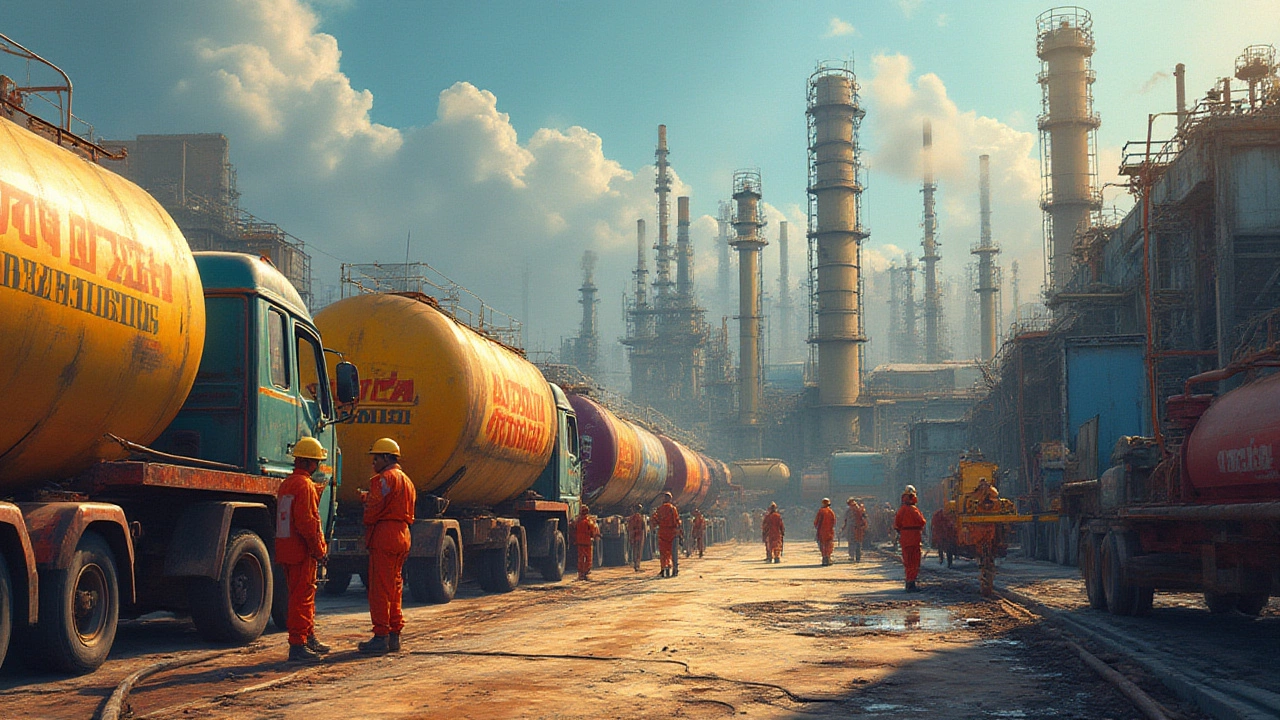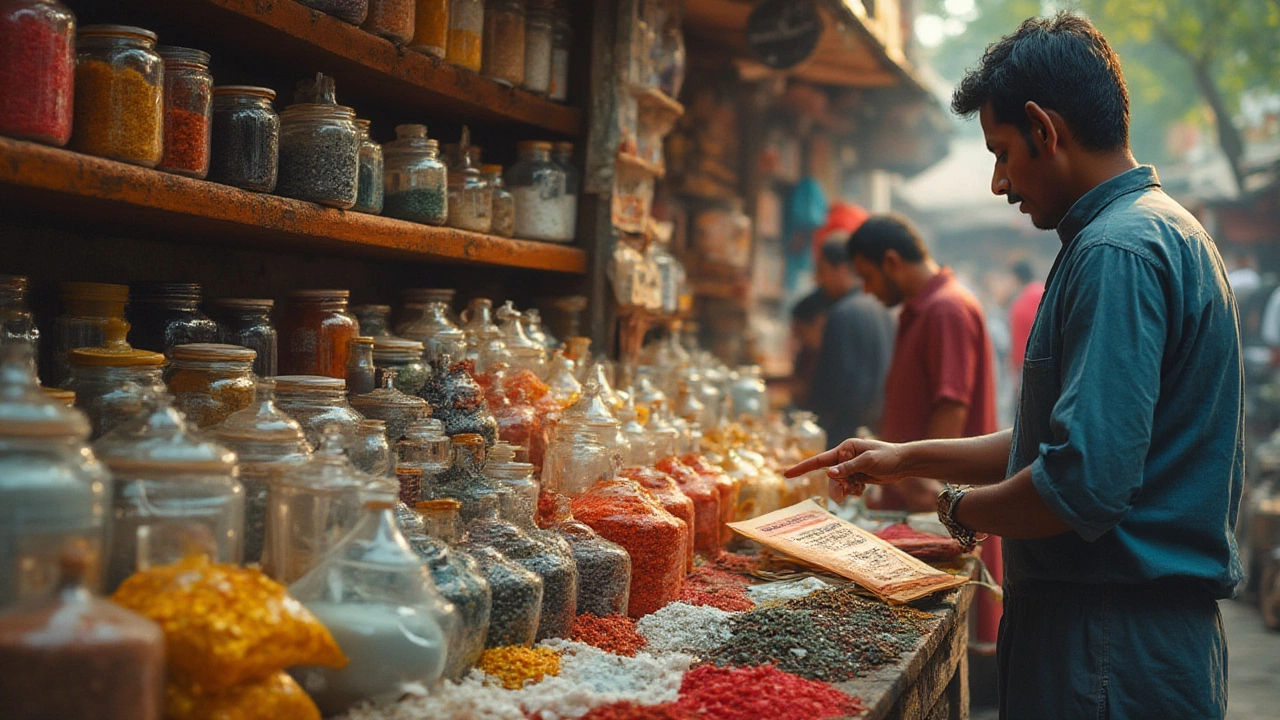
Anyone who’s watched the Indian market develop knows it’s never boring—especially in chemicals, where fortunes can change with a good monsoon, a global trade shift, or the right government policy. There’s a reason international traders watch India so closely. This country is the sixth largest chemical producer in the world, and chemical manufacturing already brings in over $180 billion a year. But what’s really moving in the Indian market? Let’s dig into which chemical products India is snapping up faster than you can say "raw material shortage." Get ready to see why so many entrepreneurs are eyeing this market, whether they’re seasoned players or just dipping their toes in for the first time.
Fertilizers, Agrochemicals, and the Backbone of Indian Agriculture
You can’t talk about India’s chemical industry without mentioning agriculture. With over half the population still connected to farming—even in 2025—chemicals that boost crop yields are absolute essentials. The biggest names here are urea, diammonium phosphate (DAP), and a range of potash-based fertilizers. India actually ranks as the second-largest consumer of fertilizers globally, second only to China. Annually, India uses more than 60 million tonnes of fertilizer—imagine filling up the Sydney Opera House with that!
But it’s not just basic fertilizers that are flying off the shelves. The demand for specialty agrochemicals—like herbicides, fungicides, and insecticides—is growing at a double-digit rate each year. Why? Indian farmers are moving from traditional broadcast methods to more targeted, sustainable spraying and soil management. This means big growth for products like glyphosate, mancozeb, and sulfosulfuron. Companies like UPL, Rallis India, and Bayer CropScience are constantly rolling out new blends tailored for Indian crops, from rice paddies in the south to wheat fields in the north.
It gets interesting with the rise of biopesticides and organic-certified agri inputs. Farmers facing stricter export standards (especially to Europe and the US) have started using neem-based and pyrethrin products. That said, these greener alternatives are still only a small percent of the total market. The government’s push with subsidies and rural chemical cooperatives keeps basic fertilizer demand steady, but climate volatility and soil health trends could change the game. One surprising fact—India still imports the majority of its potash and phosphates, mostly from Russia, Canada, and Israel, which means every change in global prices is felt down to the village grocer.

Specialty Chemicals and Everyday Essentials
If you’re wearing a colorful t-shirt, popping a painkiller, or washing your hands in a sparkling clean bathroom in Mumbai, chances are you’ve used more than a handful of specialty chemicals made or sold in India. Demand for these products is sky-high and growing even faster than the basic chemical sector. This section covers dyes and pigments, surfactants, construction chemicals, coatings, and personal care additives—stuff that ends up everywhere, from car paint to your kid’s backpack zipper.
Dyes are a massive part of the puzzle, especially with the textile industry still booming in Tamil Nadu, Gujarat, and West Bengal. Indian manufacturers like Atul Ltd and Bodal Chemicals have carved out strong positions not just at home but in markets across Southeast Asia and Africa. Up to 80% of India’s dye and pigment output is used domestically thanks to fashion demand and government support for "Make in India".
Personal care chemicals are no less in demand. Shampoos, lotions, soaps—India’s growing middle-class population is a goldmine for international players like BASF, Evonik, and homegrown heavyweights such as Galaxy Surfactants. Sodium lauryl sulfate and other surfactants make up the building blocks for all those sudsy products you see in Indian supermarkets. Even a single festival season can drive up demand as much as 20% for certain cleaning and coloring chemicals! Here’s a tip: if you’re thinking of a chemical business, find out the festival calendar first—buyers stock up months ahead of time.
Construction chemicals might sound dry (pun intended), but they’re crucial for India’s huge infrastructure projects—metros, highways, you name it. Water-proofing compounds, concrete admixtures, and sealants are in big demand as builders battle extreme weather and tight deadlines. Sika India, Pidilite, and Fosroc are the front-runners here. If you want one mind-blowing figure—India uses more than four million tonnes of paint and coating chemicals every single year, from luxury condos in Gurgaon to small homes in rural Maharashtra.
And don’t forget about the specialty chemicals powering India’s automotive, electronics, and packaging industries. Flame retardants, UV stabilizers, and advanced adhesives are hot sellers (especially after the shift toward eco-friendly plastics and lighter vehicles). After COVID, demand for sanitizers and anti-microbial coatings exploded, and that spike never truly dropped off—hospitals and even railway stations still buy these products in bulk.

Bulk and Industrial Chemicals: The Powerhouse of Indian Industry
Beyond agriculture and day-to-day basics, India relies heavily on industrial chemicals for manufacturing, energy, water treatment, and more. Think of them as the silent giants in everything from a glass of drinking water in Bangalore to the steel frames of a Surat skyscraper. The top names here are sulfuric acid, caustic soda, ethylene, propylene, and methanol—without them, half the country’s basic industries would grind to a halt.
Take sulfuric acid. India produces over 18 million tonnes per year, making it one of the world’s largest markets. Its main uses? Fertilizers, battery manufacturing, and even sugar refining. Caustic soda, on the other hand, is the unsung hero of India’s textiles, papermaking, and soap industries. Companies like Grasim Industries and Gujarat Alkalies churn out caustic soda 24/7, and whenever there’s a hiccup in global shipping, Indian processors feel the ripple within days.
Now, polymers are a key chapter of this story. With every new car, fridge, or packaged snack, India’s appetite for polyethylene, polypropylene, and PVC grows stronger. Reliance Industries, the country’s largest firm, produces millions of tonnes annually—think enough plastic to wrap around Earth several times. And it keeps climbing. By 2030, some analysts predict India will double its current plastic polymer output, driven by urbanization and consumer spending.
Industrial gases like oxygen and nitrogen might have quietly moved along for decades, but COVID changed all that. Suddenly, people across the nation became aware of just how critical medical and industrial oxygen was to saving lives and keeping factories humming. A steady supply of compressed gases is now an absolute requirement for everything from hospitals to food-processing plants, especially after major Durgapur and Panipat plant expansions.
Here’s a wild fact—India has the world’s largest single-site refinery at Jamnagar, which produces not just petrol but a mind-boggling range of specialty and bulk chemicals—many of which are snapped up all over Asia, Africa, and the Middle East. If you track shipments from Jamnagar’s chemical docks, you can practically map out tomorrow’s trends in Indian and regional industry.
Some other essentials: adhesives and resins, acetic acid, sodium bicarbonate (yup, baking soda for everything from factory cleaning to biscuit making), and the dyes that go into everything from schoolbooks to currency notes. Many industries have started looking hard at greening these segments. Petrochemical companies are experimenting with bio-based feedstocks, and industrial plants now face stricter rules on emissions and waste management.
For those hunting for a business edge, here’s something Emily pointed out last time we discussed the news—Indian importers are always looking out for new, cost-effective chemical sources, partly thanks to volatility with Chinese suppliers or global disruptions like the Red Sea crisis. If you have a product that can help Indian manufacturers cut costs or boost quality, you’re in for a very warm welcome—especially if you offer great after-sales service and can navigate the tricky bureaucracy on the ground.
Anyone serious about chemical manufacturing in India should keep half an eye on government policies, too. The "Production-Linked Incentive" schemes for chemicals and specialty industries are set to inject billions of rupees in subsidies for local players through 2026. So whether it’s industrial caustic soda or a new anti-bacterial additive, India’s chemical appetite isn’t slowing down any time soon.